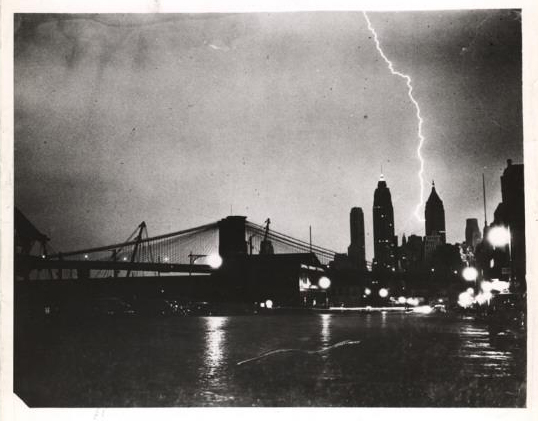
Despite its name, the Brooklyn Bridge has always seemed to belong more to Manhattan than to Brooklyn. Weegee’s 1940 photo of lighting bolt apparently striking the then Bank of Manhattan Trust Building says as much. By foregrounding the photo with the Brooklyn Bridge leading to the skyscrapers of Manhattan — and with Brooklyn nowhere in sight — Weegee captured a popular view of the bridge that follows, and has been followed, by many who have photographed it. The typical act of photographing the Brooklyn Bridge probably goes something like this: cross over to the Brooklyn end of the bridge, turn around, and point your camera towards Lower Manhattan. Unlike the mess of low-rise buildings and wharves of Brooklyn, the gleaming skyscrapers across the East River form the prefect backdrop to accompany the engineering marvel.
But the Brooklyn Bridge was not always portrayed as the umbilical cord of Manhattan. When the bridge first opened on 24th May, 1883, many newspapers and magazines ran a color painting depicting the grand display of fireworks above it through the “view from New York, looking towards Brooklyn.” Another illustration from the same period also depicted the bridge from this perspective, although it is actually difficult to tell the two cities apart. Then, Manhattan had not yet been planted with the skyline of skyscrapers that would one day distinguish it from Brooklyn. In fact, when the bridge was built, Brooklyn was an independent city and it wasn’t until close to two decades later in 1898 that it was consolidated with the other boroughs to form the modern New York City that we know today.
When it first opened, the Brooklyn Bridge was the world’s first steel-wire suspension bridge and boasted the longest span in the world, stretching some 1,600 feet from tower to tower. Such an engineering feat foretold the coming of new construction techniques that would revolutionize buildings in the early 20th century, leading to the birth and proliferation of skyscrapers in Manhattan, the world’s financial capital. It was such a city that Weegee — then known as Arthur Felling — arrived at in 1909 when he traveled from Austria to join his father here. By then, the tale of two cities between the Brooklyn Bridge was already set in motion. Living for close to six decades in New York, Weegee saw the bridge struggle to hold on to Manhattan and Brooklyn as a growing gap in development emerged. Even his photos showed that: most of it were shot in Manhattan, where life in New York City happened. On the other hand, Brooklyn, in the words of one observer, was just the “bedroom” for the thousands who worked in Manhattan.
As capital and construction flowed towards Manhattan, so did the Brooklyn Bridge. It seemed Brooklyn was no longer worthy to frame the bridge named after it. Photo after photo from the 1960s onwards depict it against the skyline of Manhattan, which together formed a picture perfect postcard of New York City’s engineering and financial might combined. Some five years after Weegee passed away in 1968, this image was cemented in the minds of the people. Then, a new architectural and engineering marvel had arrived in Manhattan: the World Trade Center, which was the tallest buildings in the world when it completed in 1973. These twin buildings, each standing at 1,368 feet, mirrored Brooklyn Bridge’s two towers — except both were in Manhattan. As the World Trade Center became recognized as quintessentially New York over the years, so did this view of the Brooklyn Bridge foregrounding it. In the years after the 9-11 tragedy, the bridge seemed to lose some of its distinction without the missing World Trade Center towers. Something just seemed missing in photos, although the upcoming One World Trade Center should restore Manhattan’s allure over the Brooklyn Bridge.
Manhattan’s monopoly over the gaze of the Brooklyn Bridge may not be for much longer though. With gentrification and its growing reputation as a hip neighborhood to live, work and play, it is getting tougher to overlook Brooklyn. The borough has seen a few skyscrapers spring up too, although nothing particularly notable in terms of architecture yet. But why should it follow in the footsteps of Manhattan and fall into some race for the skies? The conversion of Brooklyn’s former piers and wharves into parks and other kind of public spaces create a different kind of background and frame for the Brooklyn Bridge, which could be just as interesting when viewed across the river.
Like how the Brooklyn Bridge’s suspension system is kept together by tension, the disparity between Manhattan and Brooklyn is what keeps people returning to photograph this New York City icon. We each pick our sides and angles to get a picture of what we think the city looks like through our eyes.
Manhattan or Brooklyn, which side are you on?
———–
Written for Adam Levy’s Researching Design class at D-Crit.


